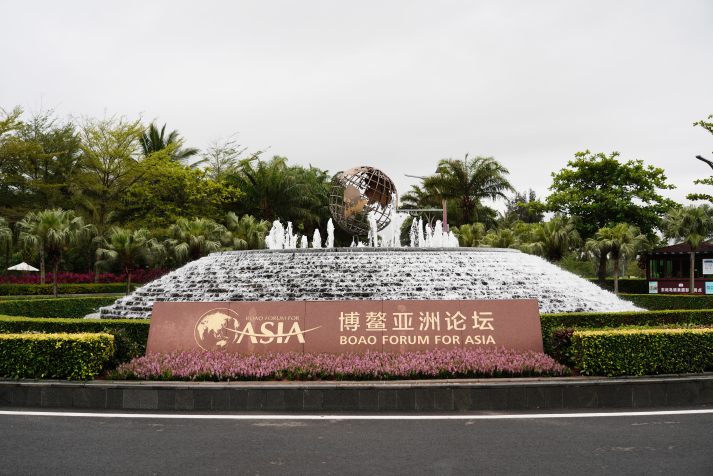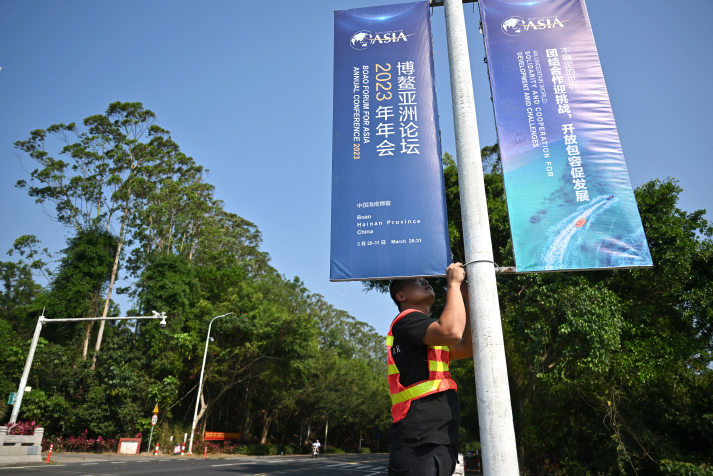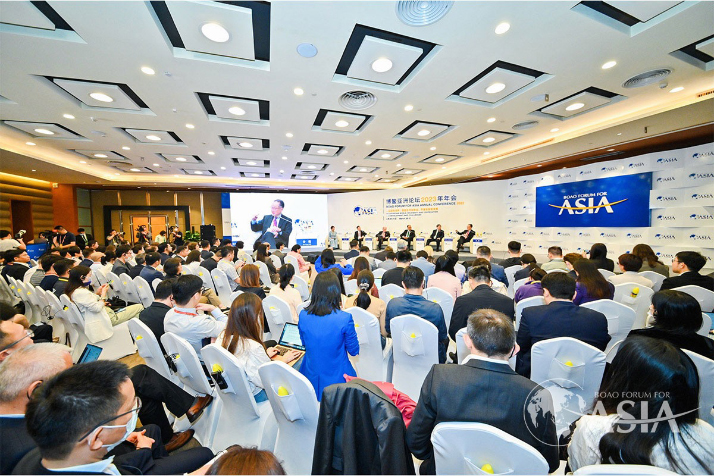| China |
| Boao 2023, a catalyst for innovative ideas and collaborative initiatives | |
|
|
 A square in front of the Boao Forum for Asia (BFA) International Conference Center in Boao, Hainan Province, on March 27 (XINHUA)
In a global context of geopolitical wrangling and lingering pandemic impacts such as supply chain disruptions, state leaders, government officials and heads of international organizations, as well as scholars and entrepreneurs from the world over, gathered on China's tropical island province of Hainan for the Boao Forum for Asia (BFA) annual conference—a meeting of minds that took place entirely offline once again from March 28 to 31. The previous two editions of the event occurred both online and offline due to the COVID-19 pandemic; the 2020 annual conference was canceled altogether. The BFA takes its name from the town of Boao, once just a small fishing village in Hainan, which has been the permanent venue for the annual conference since 2001. Committed to promoting regional economic integration, this year's edition, themed An Uncertain World: Solidarity and Cooperation for Development Amid Challenges, again set out to offer the world an Asian vision for shared prosperity. On March 30, Chinese Premier Li Qiang attended the annual conference's opening ceremony and delivered his first major public speech after assuming office in mid-March. "Today, both Asia and the world stand at the crossroads of historical evolution," Li said, urging for more efforts to jointly safeguard a peaceful and stable environment for development and inject more certainty into a volatile global environment. He further mentioned that China's economy had performed better in March, reflecting how it "possesses strong resilience, potential and vitality."  A staff member hangs posters for the BFA Annual Conference 2023 in Boao on March 23 (XINHUA)
A world of uncertainty Supply chain disruptions, post-pandemic economic recovery, clean energy and geopolitical tensions topped the agenda of this year's BFA annual conference. "The past few years have seen things getting worse. This is not only unfair and unjust, but economically unreliable and unsustainable," Ban Ki-moon, Chairman of the BFA, said at the opening ceremony. Echoing this year's BFA theme, the former UN secretary general expressed his hopes the gathering would find certainty in uncertain times. "After so many crises, shocks and surprises, it's time to go ahead and plan for a shared future. It is time for renewed action on long-term challenges," Ban said. BFA Secretary General Li Baodong stressed that a range of major challenges presently highlights the world's uncertain status quo—from the pandemic, geopolitical conflicts and the world's economic downturn to global warming. "No one challenge just relates to the present; it also influences the future," he said. "You reap what you sow and different policies will lead to different results." Though COVID-19 is a public health crisis, it has also wreaked havoc on global economic development; and the geopolitical character of the Russia-Ukraine conflict has driven energy and food prices to staggering levels. For many people around the world, inflation became a top concern in 2022. And it was one of the biggest topics of discussion during this year's conference. "The global economy is undergoing a cyclical transformation, from an easing cycle to a tightening cycle—the latter being one of high inflation, high interest rates, high debt and low growth," Zhu Min, former Deputy Managing Director of the International Monetary Fund (IMF) and Vice Chairman of the China Center for International Economic Exchanges, told Beijing Review. "Face the reality and remain confident" was among the most frequently heard lines coming from participants on different occasions throughout the conference.  A panel discussion themed The Belt and Road: Sharing the Opportunities of Development during the BFA Annual Conference 2023 in Boao on March 28 (XINHUA)
Spotlight on Asia In a January report, the IMF said Asia's economic growth rate is expected to rise from 4.3 percent in 2022 to 5.3 percent this year. By comparison, it predicted a global economic growth rate of 2.9 percent for 2023, slightly higher than its October 2022 forecast, but still significantly lower than the historical average of 3.8 percent in the 2000-19 period. Asia's weighted real GDP growth rate, or the rate of real output growth, in 2023 is estimated at 4.5 percent, an increase of 0.3 percentage points from 2022, according to a report released by the BFA on March 28. Asia, a bright spot in the bleak global economic landscape, will continue to advance regional production, trade, investment and financial integration and cohesion, and seize the "Asian moment" for global economic governance, the BFA report further read. Most international BFA attendees voiced their belief that the importance of Asia in the world economy continues to grow and the dynamic cooperation among and development of Asian countries, especially China, has brought confidence and stability to the world at large. One year after the Regional Comprehensive Economic Partnership (RCEP) agreement came into effect, the dividends of institutional opening for trade and investment in the region are constantly emerging. In January 2022, the RCEP became the world's largest free trade deal involving 10 Association of Southeast Asian Nations (ASEAN) countries, as well as China, Japan, the Republic of Korea, Australia and New Zealand—altogether representing 30 percent of global GDP. China's official data showed that the country's trade with other RCEP signatories expanded 7.5 percent year on year to 12.9 trillion yuan ($1.87 trillion) in 2022, accounting for 30.8 percent of China's total foreign trade value. Judging by major economic indicators in the first months of 2023, the rebound of the Chinese economy is well underway, with many international institutions raising their forecasts about the country's economic growth for this year. In February, the IMF already lifted its projection for China's economic growth in 2023 to 5.2 percent from a previous prediction of 4.4 percent. However, Lin Guijun, Vice President of the Beijing-based University of International Business and Economics, did emphasize that China's domestic consumption, a major growth driver, will take time to fully recover from the effects of COVID-19. "One sign is that domestic demand is not quite keeping up; specifically, revenge spending (referring to the post-pandemic urge to spend money) is rarely heard of in China anymore," he told Beijing Review. Call for cooperation In recent years, several developed economies such as the U.S., the EU and Japan have tried to revive their manufacturing industries. Through legal regulations and economic subsidies, these countries inspired domestic enterprises to increase investment in their own countries, sparking a trend of localization in the current global supply chain. Several developing Southeast Asian countries, e.g., Viet Nam, then, have continued to rely on their domestic low-cost labor force and preferential investment policies to attract foreign investment and actively undertake international industrial transfers. As a result, some foreign-funded enterprises in China decided to shift their factories out of China. In view of the phenomenon, Yao Yang, Dean of the National School of Development at Peking University, pointed out that it is reasonable for companies to give several countries a try in search of the right balance between cost and quality. Nevertheless, he said that to his knowledge, businesses that have moved out account for only a relatively small part of China's economy and trade volume. At the same time, Yao was of the opinion that this might be a good thing for China as it would mean the country has upgraded its industry. "Generally speaking, it's hard to find a better investment market than China," Lin said. "Of course, there are more trade restrictions and obstacles ahead," Hans-Paul Burkner, Global Chair Emeritus of U.S.-based Boston Consulting Group, said during the annual conference, further stressing the importance of global cooperation. "Complete self-sufficiency is unrealistic, whether it's in the automotive industry or in electronics," he added. He explained how all industries have a great need for working together "because valuable input is coming in from all over the world, not just from one place." "The world is seeing some realignment of the global and regional supply chains, but overall, the trend is still positive," he said. "It will take more than a decade for Southeast Asia to become a manufacturing hub like China. Europe and North America will take even more time," Ben Simpfendorfer, a partner at leading international management consulting firm Oliver Wyman, told a subforum on the global industrial and supply chain landscape during the conference on March 28. "China will remain the world's No.1 manufacturing hub. Eighty percent of smartphone exports come from China and though this figure may decline slightly, no other market has the same speed and scale as China," Simpfendorfer told Beijing Review. He also articulated his confidence about the country's consumer and capital spending picking up again sooner rather than later. "We were excited to hear Premier Li's talk about not only expanding domestic demand, but also ensuring the country continues to open up," he added. China has shared its story of development with the rest of the world, Renat Bekturov, Governor of Astana International Financial Center, a financial services hub operating in Kazakhstan, said. "Thanks to the Belt and Road Initiative, we are generating so many new projects and ideas, all driving investment in the country. We need that to grow our economy and elevate the living standards of our people," he said. The initiative he referred to was first proposed by China in 2013 to boost connectivity along and beyond the ancient Silk Road routes. He also underlined how digitalization is an important area to invest in because trade is not only about physical, but also about soft infrastructure. "If goods can move freely when digitized, that will reduce the trading costs of exporting and importing and in turn lower trade barriers," he explained. Printed edition title: Sowing and Reaping Copyedited by Elsbeth van Paridon Comments to taozihui@cicgamericas.com |
|
||||||||||||||||||||||||||||||
|
